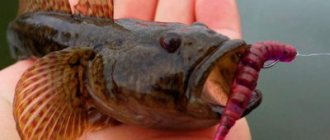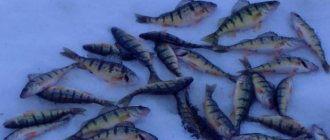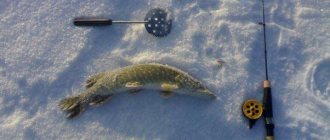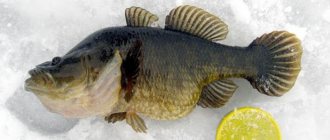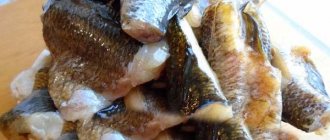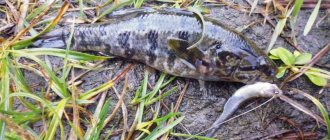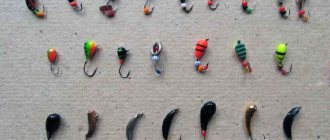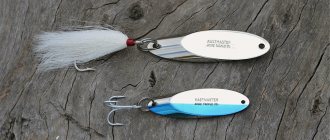Winter fishing is great for outdoor enthusiasts. And although most fish become less active with the onset of cold weather due to low oxygen levels in the water, it is still possible to get a rich catch. This also applies to rotan, which can be caught in winter from the ice using jigs and live bait.
Fishing for rotan in winter has some features that distinguish it from summer fishing. In order not to be left without a catch, you should study in advance the nature and habits of this fish, its favorite habitats and the types of gear that are best used for fishing.
Fishing for rotan in winter
Rotan is a small predatory fish that was originally found only in the Far East. But after the fish was brought to the European part of Russia, several specimens ended up in local reservoirs, and the number of fish increased so much that now fishing for this underwater predator is not considered something outlandish.
Note: Many people mistakenly believe that fishing for rotan is a boring activity. In fact, this predator is very cunning and resourceful. Therefore, in order to catch a large specimen, you will have to choose the right bait and show some skill during the fishing process.
Knowing the habits of rotan in winter will help you get a rich catch, because with the advent of cold weather they change significantly. For example, when the first ice begins to form, rotans do not migrate, but remain in the same feeding areas as in the summer. As a rule, for this purpose they choose areas near the shore with a depth of up to 1 meter (Figure 1).
Figure 1. You can fish for rotan all year round
However, already in the middle of winter, the fish prefers to move away from the shore to areas with greater depth. This is due to the almost complete death of vegetation near the coast. In addition, rotan is a predator, and therefore migrates to those areas where it can get food for itself in the form of small fish. In other words, when the cold gets worse, rotans move to areas with a depth of about one and a half meters, and they can settle both on a flat bottom and on rifts. With the onset of deep winter, due to the low oxygen content in the water, rotan becomes very sluggish and extremely cautious, and it is very difficult to catch it during this period.
Like other aquatic inhabitants, sleepers have difficulty withstanding winter, but their habits differ in many ways from other fish:
- On the eve of cold weather, they begin to eat intensively in order to saturate their bodies with nutrients before the onset of severe frosts.
- Unlike other types of fish, which prefer to flock into large schools and hide in warm, deep holes and pools, rotan leads a solitary life even in winter.
- The only option when these predatory fish can flock together is in a very frosty winter, during which the reservoir freezes to the very bottom. In such conditions, rotans gather in groups, and, as the water freezes, they fall into suspended animation. An air-ice mass of a certain temperature forms around the flock. It does not fall below the critical level for the fish, so with the onset of spring they come to life again.
Taking these features into account, you need to choose the right bait and place for fishing. If you know the features of the reservoir, you will not have any problems with this, but when fishing in unfamiliar places, information on finding rotans under the ice may be useful.
Tackle for rotan in winter
During thaws, a winter float rod is used for fishing for rotan in reservoirs with standing water. To attract fish to the fishing site, bait should be used. Chopped worms, bloodworms and animal waste are suitable as bait. It is impossible to miss the bite of rotan during stationary fishing. It usually self-cuts. The main thing is to securely fasten the fishing rods to the ice surface.
Where to look for rotan in winter
If you are going to catch rotan in an unfamiliar body of water, you should know where to look for this cunning underwater predator. You should immediately prepare for the fact that finding it is not so easy, so when going fishing, carefully examine the surrounding area. This will help determine possible habitats for future catches.
Typically rotans prefer to settle in the following areas:
- Thickets of reeds or bushes located directly near the shore. In such areas, you can find an underwater predator at the beginning of winter, when the first ice has just begun to form (Figure 2).
- Dense weed beds containing small fish or other aquatic life are also considered good fishing spots. Naturally, it is better to identify such areas before the onset of cold weather, when underwater vegetation is clearly visible.
- You can also find predatory fish in cluttered areas of the reservoir, where there are a lot of fallen trees, branches, snags or other debris of natural origin.
- Rotans also like to settle on the border between vegetation and the bare bottom. In addition, the predator can be found in areas located between holes and shallow water, because this is where the bulk of fish prefer to hide.
Figure 2. Predatory fish prefers to settle in swampy and overgrown reservoirs.
In winter, rotan can be found at the confluence of streams and small rivers, as well as where cold springs gush out from under the water. The thing is that such cold water contains much more oxygen than other parts of the reservoir. If you manage to find such a place, successful fishing for rotan can last all winter. As a rule, these underwater predators prefer to settle near the very bottom, but in some cases they can be caught in shallow water.
What gear to catch rotan in winter
After selecting a reservoir and identifying promising places, the angler begins fishing. For fishing for rotan in winter, several methods are used, which have their pros and cons:
- winter spinner;
- jig;
- float tackle with a hook;
- float tackle with jig.
Winter spoons are convenient because they allow you to quickly fish large areas, collecting active fish. This gear is suitable for fishing in reservoirs where there is a lot of large rotan. Having caught a certain amount of fish, when the bite dies down, switch to a jig. Small winter spinners up to 30 mm are used, often vertical, since gliders easily collect underwater vegetation. Hooks are equipped with red beads, cambrics or threads. The game should not be very sweeping, with short, infrequent tosses and long pauses. Sometimes miniature balancers are used.
4 options for winter gear for a firebrand
Jig is the most common bait. The most commonly used jigs are silver, golden, red or black. The firebrand is not afraid of large baits and choose a large size for your own convenience. Catching rotan from ice with a jig is perhaps the most convenient option. The shape of the jig does not matter. Rotan responds well to equipping them with various pendants - chains, beads. The mouth of the firebrand is large, so you shouldn’t go too small with the size of the hooks, otherwise there will be a lot of empty hooks and drops in the process; the shank of the hook should be long.
The float fishing rod is equipped with both a hook and a jig. Rotan notices better and more readily attacks bait located in the water column, so the carrying capacity of the float is chosen so that it hangs in the water. A good effect is achieved by periodically playing along with the tackle - if there are no bites for a long time, you can slightly lift the bait, make 2-3 swings and lower it back into place. As a rule, after such manipulations a bite occurs. Float tackle is convenient for stationary fishing, placing several fishing rods close to each other.
Rotan is tolerant of rough equipment. Considering that you often have to fish in overgrown places and often have to pull the bait out of the grass, you don’t have to waste time with the fishing line. For jigs and float rigs, monofilament fishing line with a diameter of 0.12-0.18 is used, for spinners 0.18-0.25 mm. There are no requirements for fishing rods and they choose the one that is convenient for the fisherman. Hard nods are used, since the bite of rotan is most often clear and confident .
Tackle for catching rotan in winter
Winter fishing rods with spinners and jigs are considered the most productive for catching rotan. Experienced fishermen do not recommend using small gear, such as devils or small jigs. The fact is that rotan quickly and actively swallows such bait, and removing the hook from the insides of the fish will be very problematic (Figure 3).
Note: There are no special recommendations regarding the shape and color of gear, since their selection according to these parameters depends on the type of reservoir, weather conditions and the time of day chosen for fishing.
There is universal advice for successfully catching rotan: in the fisherman’s arsenal there should be several types of suitable gear, differing in shape, size and color. This way, it will be possible to select the appropriate option directly on the spot, having tested each of them in practice.
Figure 3. Types of gear for winter fishing
Separate requirements are put forward for the fishing line. It must be durable, with a cross-section of at least 0.08 mm. You should also select the fishing line in such a way that its breaking load helps you easily pull gear out of algae thickets or fish out the fish itself. Another peculiarity of rotan is that it absolutely does not react even to a noticeable fishing line, so you can easily use a thicker option, from 0.12 mm, especially if you are going to fish in large thickets.
Mormyshka
The rotan's mouth is quite large, so it swallows small tackle too deeply. In order not to remove the hook from the insides of the fish later, it is better to immediately choose larger gear. First of all, this concerns jigs, which are most often used for catching rotan (Figure 4).
Many fishermen claim that ready-made gear, which is sold in stores, is not very suitable for catching rotan in winter. A homemade jig made in accordance with personal preferences can provide a rich catch, especially since the manufacturing process itself does not present any particular difficulties.
Note: Materials and tools for work depend on the type of gear being manufactured. Some people prefer to solder or forge jigs, but for large fish it is better to use the sawing method.
To make such a jig, you will need:
- A sinker weighing 2-3 grams, pear-shaped or cone-shaped.
- Several large beads of different colors that will attract the attention of the fish.
- A large, sharp hook with a long shank and thin wire for connecting structural elements.
- As additional tools, you will use pliers, bright paint for painting the tackle, a vice and a hacksaw.
The most effective method for making a large jig is sawing. This option is simple, but the tackle will be of high quality only if you clearly follow a certain algorithm of actions. Firstly, you first need to securely fix the sinker in a vice so that it can be conveniently sawed. Secondly, you need to use a sharp hacksaw to make a clear longitudinal cut of the sinker. At the same time, it is important not to finish it to the end so that the cone does not fall apart into two parts.
Next, you need to string 3-4 beads onto a special jig hook with a long shank. It is important to choose the right beads: their holes must correspond to the thickness of the forend. As a result, you should get a design in which the beads cannot move freely along the hook, but are arranged elastically and tightly. For additional fixation, you can use cambrics.
Figure 4. Types of suitable jigs
After this, take a piece of wire, fold it in half and twist it so that you get a thin screw-shaped rod with a small hole (eye) for attaching the fishing line. On the opposite side of the rod, one of the remaining wires is cut off, and a hook is put on the second. In this case, the material must be bent so that you form a small ear, similar to the one located in the upper part. Next, use pliers to bend the tackle into a ring so that the hook can move freely along the wire, and place the rest of it parallel to the rod.
Catching Rotan on Zherlitsy in Winter. Fishing in the Moscow region
Winter zherlitsa. Rotan fishing Winter fishing. Catching rotan using girders. Bites, underwater shooting. Winter fishing with an underwater camera. Video under the ice. Fishing for rotan in winter using live bait (white fry). Rotan is a predator. Adult rotans eat eggs and fry of fish, leeches, newts, and amphibian larvae (tadpoles). Cannibalism is widespread among rotan - eating smaller individuals of its own species. When fishing, rotan often swallows bait deeply. In a small body of water, rotan becomes numerous and is capable of completely exterminating representatives of other fish species. In large reservoirs, the number of rotan is regulated by other predatory fish: pike, catfish and especially perch. Survives in the most polluted bodies of water: is not afraid of freezing - being frozen, thawing, it comes to life Large rotan is an object of amateur fishing, it bites well on an earthworm and pieces of raw meat or lard, as well as on various jigs and small spoons, just attach a bunch to the hook red threads Once caught in a pond, rotan can easily withstand transportation in a bucket of water to another body of water, where it can be used as live bait for catching predatory fish.
The underwater world of reservoirs is hidden from our view. It's like another universe, fascinating and amazing with its beauty. On the Sergei Sorokin channel you will find unique underwater filming in the natural habitats of fish. You will clearly see how fish react to different baits, baits, colors, sizes and shapes of spinners, jigs and devils! And in this way, each of us will be able to emphasize something new for ourselves! That new thing, thanks to which there will be a clear understanding of the behavior of fish under the ice!
► Link to this video, share with friends → goo.gl/pz8kTg
► My other videos on winter fishing → goo.gl/PcY0IX
►Subscribe to new videos about fishing→ goo.gl/c3a6YF
▬▬▬▬▬▬▬ I’m on social networks. Add me in friends! ▬▬▬▬▬▬▬
►VKontakte: vk.com/sergeisniper ►Odnoklassniki: goo.gl/R8mdSD
► Support the project: - Yandex wallet 41001481468192 All money raised will go to improve underwater equipment!
► For questions regarding cooperation and advertising
♻ The most popular fishing videos on my channel:
➤ Camera for winter fishing, Underwater filming under the ice - youtube.com/watch?v=BNPnNf-pDT… ➤ Winter fishing for perch. Underwater camera - youtube.com/watch?v=kOISWnHkR4… ➤ Winter fishing 2016-2017 for perch with an underwater camera. First ice youtube.com/watch?v=7ljJ5Iipob… ➤ First ice. Underwater camera for winter fishing. Fishing with a jig - youtube.com/watch?v=qX2t14773v... ➤ Winter fishing at night, Underwater video under the ice - youtube.com/watch?v=NR_KCkSUSB... ➤ At the Old Stump, Winter fishing for perch, Underwater filming - youtube.com /watch?v=cZIZsdZPGv… ➤ Winter fishing with an underwater camera. The first last ice - youtube.com/watch?v=lf98Ucxp6f... ➤ Fishing with a spinner. Underwater video online. Winter fishing - youtube.com/watch?v=BIA5VQz4jA… ➤ Winter zherlitsa. Catching rotan - youtube.com/watch?v=B118a4wgj0... ➤ Fishing with girders, Underwater video. Reaction of perch to live bait, pike in the grass. Winter fishing - youtube.com/watch?v=Csd1EwuebZ… ➤ Winter fishing. Catching Rotan with Chertik. Underwater video - youtube.com/watch?v=HoU1CIjaA9… ➤ Winter fishing with a camera. Catching perch with a jig. Underwater shooting. First ice - youtube.com/watch?v=xCUMXcVrSw... ➤ Underwater filming under the ice, Bait and fish - youtube.com/watch?v=JETUOLizmC... ➤ Perch and Jig. Winter fishing with an underwater camera - youtube.com/watch?v=p5WQk3594l... ➤ Winter bait in action, Underwater shooting - youtube.com/watch?v=uXSmjsF7jn... ➤ Fishing with live bait in winter. Bite on a dead fish. Fishing camera - youtube.com/watch?v=VQ2mW3mrd3… ➤ Perch. Fishing with two jigs in winter. Underwater camera. Winter fishing - youtube.com/watch?v=mkfjTLWVp-… ➤ Winter fishing. The predator grabs the bait! Zherlitsa. Underwater photography - youtube.com/watch?v=8iJ7JZTQZA... ➤ Winter fishing - The Last Ice, Underwater Filming - youtube.com/watch?v=luV14hUQlg... ➤ Catching perch with a jig in winter, Underwater filming - youtube.com/watch?v =5suw43JQDQ… ➤ Winter Fishing for Perch. Balance. Deaf winter. Underwater video - youtube.com/watch?v=HzBtA8Up99... ➤ Bait - underwater photography: perch, bream, roach - youtube.com/watch?v=c0o7sIAojv... ➤ Catching perch on a balance beam. Underwater camera - youtube.com/watch?v=tbX5gcEXXe… ➤ Winter fishing. Ruff and perch on a jig. Underwater camera - youtube.com/watch?v=wNvFeKbGpu… ➤ Winter fishing. Fishing for bream and roach. Underwater camera - youtube.com/watch?v=mHKRZsAHZv… ➤ Winter fishing. Underwater photography - youtube.com/watch?v=R4ssybu5is…
Winter fishing for rotan: bait
Since rotans do not flock together and prefer to hunt alone, it is hardly possible to get a large catch near a single hole. You can increase your chances of catching this fish by feeding them. For example, you can use this method to attract a predator: you can throw a raw piece of meat with blood or a little albumin (dried blood) into the hole. The characteristic smell of these products will quickly attract rotan.
Figure 7. Rotan prefers meat bait
In general, we can say that this fish can be fed with almost any animal products (Figure 7). But the most active bite is observed if tripe, chicken skin, lard without salt, sausage or pieces of raw meat or fish are thrown into the hole. If you decide to feed a predator or use the products described above as bait, you need to change it as often as possible so that the fresh smell attracts more and more fish. You can determine that the bait has lost its effectiveness by its appearance: when the meat is thoroughly soaked, this means that it has lost its smell and can be replaced.
Winter fishing technique for rotan
There are no universal tactics for catching rotan, so each fisherman independently determines which method and gear to use for fishing. Intensive play with a jig and fishing with a stationary but fresh bait are considered equally effective (Figure 8).
Note: At the same time, most professionals claim that fishing with an actively moving bait is more effective, since it is more noticeable in the water and attracts predators faster.
You can also play with gear in different ways. For example, you can first lower the jig to the bottom, and then lift it with a sharp movement and leave it at that level for several seconds. If this option does not lead to a bite, the playing technique is changed. But in any case, twitching the bait often does not make sense, since rotan simply will not be able to catch and swallow the bait.
Figure 8. Fishing technique depends on the weather and characteristics of the reservoir
Much depends on weather conditions. In the cold season, the most active bite is observed when the first ice forms, and in the early morning or late afternoon the chances of catching a large specimen increase significantly. In addition, fishing will be more successful on cloudy days, since rotans do not really like sunlight.
You can see what winter rotan fishing looks like in practice in the video.

